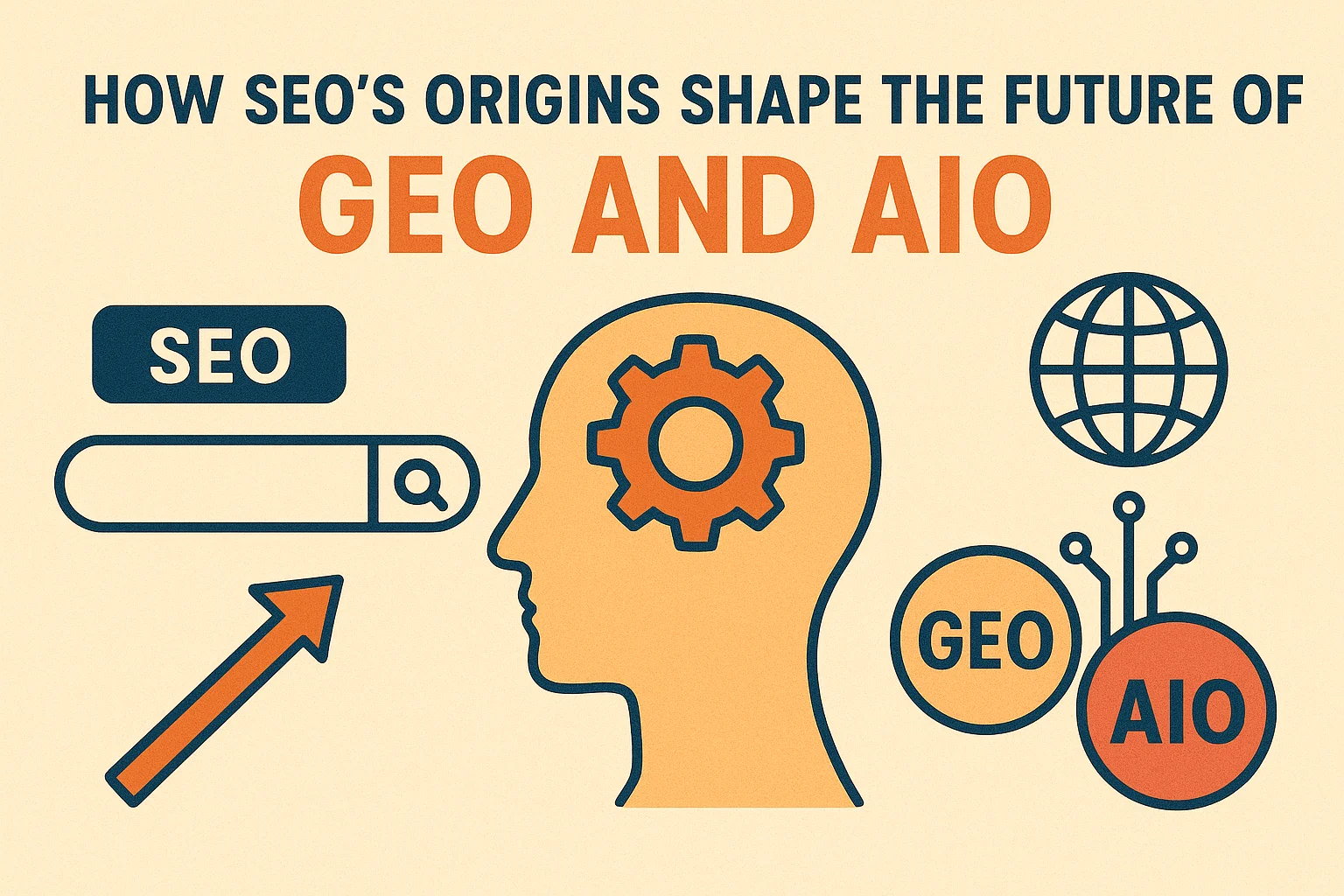At first glance, SEO might seem like an old dog in a new age — but its original story is not just a nostalgic footnote. It offers essential lessons as we shift into new paradigms such as GEO (Generative Engine Optimization) and AIO (Artificial Intelligence Optimization). Understanding how SEO was born helps us anticipate the challenges, controversies, and opportunities that lie ahead.
The Birth of “SEO” and Why the Name Matters
Back in the mid-1990s, a handful of pioneers independently arrived at the idea of “optimization” for search engines. Names like Bruce Clay, John Audette, Bob Heyman, Leland Harden — and later, industry broadcaster Danny Sullivan — all played roles in coining or popularizing the term “search engine optimization.”
Interestingly, they didn’t necessarily coordinate with one another. The term “optimization” already existed in computing, systems, and marketing, so applying it to “search engine” made conceptual sense to multiple thinkers. What followed was a collective acceptance and gradual consensus around “SEO” as the standard label.
That naming process turned out to matter more than many realize — because future acronyms (GEO, AIO, AEO) are in a similar contest for legitimacy, understanding, and adoption.
One key issue: the grammatical or logical tension in “optimization.” As some industry veterans have pointed out, you can’t truly “optimize a search engine” — rather, you optimize for a search engine (or algorithm). That subtle distinction has long been debated, and it echoes into how we use terms like GEO or AIO. If “optimization” remains part of the acronym, what exactly are we optimizing, and for whom?
From SEO to GEO / AIO: Evolution of Thinking
As AI, large language models, and generative systems permeate search, marketers and technologists are asking: is “SEO” still sufficient? Or do we need a new lens?
That’s where terms like GEO (Generative Engine Optimization) or AIO (Artificial Intelligence Optimization) come in. These are attempts to reimagine or rebrand what modern search (and discovery) looks like when content is generated or mediated by AI.
Yet, the challenges echo the early days of SEO:
-
Who gets credit for naming or popularizing the term? Just as SEO’s naming involved multiple parties, the current acronyms are being hashed out across the industry.
-
What is the precise definition? GEO and AIO risk suffering the same clarity problems as SEO’s early days — will they be universally understood, or remain fragmented?
-
Are they just “specialties under SEO,” or entirely new paradigms? Some thinkers argue that geo/AIO are subsets or evolutions under the broad SEO umbrella.
One interesting tension is that GEO (the “G” for generative engine) carries an unintended semantic conflict: in marketing, “geo” is often associated with geography (local search, location). That overlap of meaning can cause confusion. Also, calling AI systems “generative engines” is not yet common in practice — most people refer to LLMs, AI, GPTs, etc., not “the generative engine.”
Lessons from SEO’s Early Days — What to Watch For
By revisiting the origin story of SEO, we can draw key lessons for how GEO and AIO might succeed (or stumble). Here are a few:
1. Consensus is hard — standards emerge slowly
When SEO was new, the community was small, and terms could gain traction more easily. Now, with millions of marketers, technologists, and organizations, different camps may adopt different nomenclature (GEO, AIO, AEO), leading to fragmentation.
2. The name frames the narrative
Because SEO’s naming debate included notions of clarity, credit, and framing, it shaped how people thought about “optimization.” Similarly, the choice of GEO vs AIO vs something else will influence how practitioners conceptualize their work — whether through generative content, autonomous agents, etc.
3. New terms must encompass core value
SEO always centered on visibility, relevance, authority, and ranking. The newer paradigms (GEO/AIO) must carry forward those principles while expanding into AI-specific domains — e.g. model alignment, automation, agentic workflows, prompt engineering. If a term fails to reflect those core values, it may not stick.
4. Grammatical and semantic coherence matter
SEO’s early grammarians questioned whether “optimize a search engine” was strictly logical. The same scrutiny will apply to “optimize a generative engine” or “optimize artificial intelligence.” Terms must be precise enough to survive industry scrutiny.
5. Don’t lose the human / automation balance
One critique of GEO is that it emphasizes “optimization for generative outputs” but misses a critical part of what AI enables: autonomous workflows, agentic behavior, intelligent delivery. Simply optimizing content is less meaningful if you’re not leveraging the automation opportunity.
What the Future Might Hold
Looking ahead, we can expect several possibilities:
-
Multiple coexistence: Much like “SEO” has persisted even as marketing segments like local SEO, technical SEO, content SEO, etc. exist, we may see several acronyms cohabit (SEO, GEO, AIO, AEO), each used in context.
-
Consolidation around one term: Over time, the community might converge on a term that feels linguistically satisfying, semantically robust, and broadly adopted.
-
Evolution of meaning: The term(s) may shift over time — just as “SEO” today has many facets beyond its original connotation, GEO/AIO may mutate in meaning as capabilities evolve.
-
Focus on outcomes over labels: For many practitioners and businesses, the emphasis will move away from debating terms and more toward what works — the strategies, tools, metrics that drive performance in an AI-mediated search era.
Conclusion
The story behind SEO’s origin is not just trivia — it provides a template for how new industry terms emerge, evolve, and either endure or fade. As the marketing and search world moves into generative, AI-driven territory, the fate of acronyms like GEO and AIO will be shaped by lessons from the past: clarity, consensus, coherence, and alignment with value.





